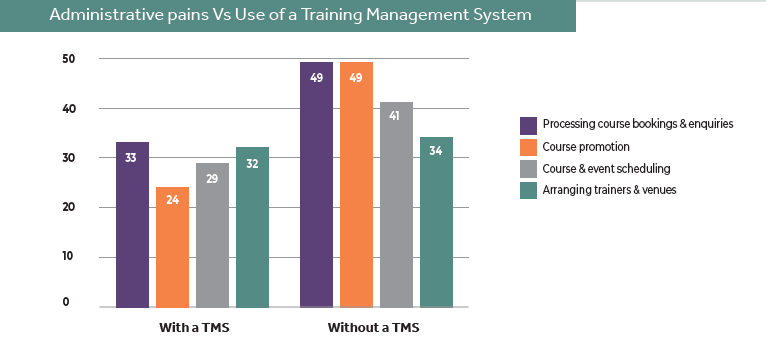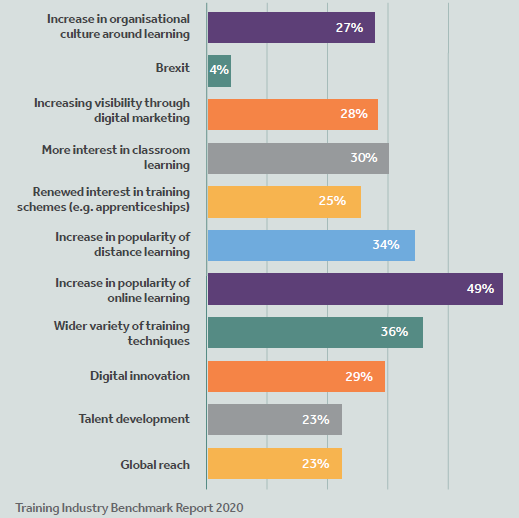Future-Proofing Your Training Business During COVID-19

If there's one objective business leaders can all unite on this year, it's trying to ensure that our business has a future. Meeting the shifting demands of the 'new normal' is critical in order to enable short-term continuity, however we must also consider what's required of us long-term, in order to promote the future longevity of our training business.
Future-proofing is the process of preparing for what's to come, both trying to anticipate the future and minimising potentially detrimental outcomes by staying one step ahead.
From conversations with our customers, we've uncovered six things agile training businesses are doing right now to help encourage the long-term survival of their training organisation, through technology, personnel, planning and research.
Introduce Online Learning
Online learning has increased in popularity among training providers for several years now, and for good reason. Our annual training industry report found 69% of training professionals were looking to introduce online learning to their training provision in the coming 12 months.
Note: This study was conducted in March 2020; following the COVID-19 pandemic, the true number of those looking to introduce online learning is likely to be much higher!
.png?width=1000&name=New%20Project%20(48).png)
Whether delegates are watching a session recording, digesting eLearning content, completing assessments or accessing course information, online learning environments are less reliant on specific dates, times or locations unlike classroom based training.
While online learning, for some, is simply being used as a stop-gap until social distancing measures are lifted, there's many more providers who are actively embedding it as part of a long term blended learning strategy. But, why is this? Well, we think there are four key reasons why you should consider introducing online learning in order to help future-proof your training business.
Generation Z
Generation Z are a demographic cohort that were born from the mid-1990's onwards, and they represent our newcomers to the training space. With lives busier than ever, the learning experience of our 'digital natives' demands four key things: easy accessibility, on-demand learning, bitesize content and social collaboration.
Increased Reach
Online learning isn't restricted by geography. Sure, there has to be considerations for language translation and accessibility, however online learning allows the universe to become your market, offering unrivalled chance for business expansion.
Reduced Cost
Online learning typically involves some start-up investment, however ongoing costs of providing training are a fraction of what classroom-based courses cost, as you don't have to consider paying for venues, travel, accommodation, meals or printed material.
Some providers also open up live online training sessions to more learners than would normally be trained in a classroom, increasing the viability of courses even further.
Technological Advancement
Modern-day innovations within learning technology and delivery almost always benefits the online learner, opposed to the classroom based learner. Things like simulation and gamification are now widely used, engaging training experiences, alongside interactive leaderboards and social collaboration spaces for learners.
It's not hard to see why online learning is quickly becoming the first key step for training providers looking to future-proof their training business. The ability to deliver a low cost, engaging training experience on a sizeable scale is a rather attractive prospect for business leaders currently involved in future planning.
Empower & Upskill Your Workforce
Your most important assets are your people. Having the right team in place and prioritising their development is perhaps the most important future-proofing step your business can take. We think there's two key ways you can help future proof your training business through your workforce,
Empowering Your Staff
Empowering your staff can be achieved in a number of different ways. The training world is in a new phase of experimentation, and encouraging the contributions and involvement of your staff will provide both a great morale boost, increase engagement on their part and bring new ideas to the table. Things like providing generous boundaries, listening more intently and giving more praise are other important things to consider - check out the full list by Forbes.
Upskilling Your Staff
Investing in your employee's professional development is a great way to help future proof your training business in the following ways:
- Improved knowledge across the business and ability to cover other roles as required
- Increased ability to do their job more effectively and productively
- Improved morale and satisfaction
- Attract better candidates when recruiting
By empowering and upskilling your staff, your business becomes a place of growth, inclusion and satisfaction. For staff, the role becomes harder to leave through ongoing development opportunities, and for the business it allows staff to become more effective and more productive in their role.
We recently ran a webinar on how to manage the wellbeing and motivation of your staff during the pandemic, and what this can do for your training business.
At accessplanit, we have a Talent Manager, responsible for creating a training academy designed to identify skill gaps, increase competence within the business and establish future learning plans. All of this contributes to having a organisation that is well prepared for the future.
Do Market Research
In order to guarantee the long-term survival of your training business, you need to stay one step ahead of the curve. There's a number of ways you can do this.
Surveying competition
Keeping a keen eye on your main competitors is critical for your training businesses' future. It could involve seeing what content they're creating, the courses they're promoting, new staff hires, website changes or even the technology they're using.
One of the great benefits of the digital world is that we can see rather quickly and transparently what our competitors are up to, just using simple, free, online tools. Check out some of the most popular below:
Google Alerts: A free tool useful for letting you know when your competitors have been mentioned online
Google Keyword Planner: Another free Google tool that allows you to see what keywords your competitors are targeting to bring traffic to their website (both paid and organic)
Feedly: A content marketing tool to help you see when your competitors post new content
Company Check: A free tool that allows you to see high-level company information for UK businesses
Industry knowledge
While attending events in-person may be difficult due to social distancing measures, there's a number of online resources that can help you stay up to date with industry trends:
- Webinars - Check out the resources and recordings from our 2-day training industry event
- Blogs - Some of the most popular include Training Industry, Training Magazine and accessplanit's blog (remember to subscribe to blog notifications!)
- Social Media - Join Groups and actively engage in industry discussions
- Podcasts - Check out Elucidat's top 10 L&D podcasts
- Reports - Download our 2020 Training Industry Benchmark Report
- Forums
- Newsletters
Trend Analysis
If you've never come across Google Trends before, I suggest checking it out. It allows you to enter multiple keywords and see in-depth search interest across any time period since 2004. I decided to compare the search terms 'NEBOSH' 'IOSH' and 'First Aid at Work' to see how these keywords were trending over the past five years.

It's clear that IOSH and NEBOSH are more 'searched for' queries than first aid at work, however it's also worth analysing how each has individually performed over time. If your chosen keywords are on the decline, it's perhaps time to see what people are searching for instead.
The aim of trend analysis is to use the past to try and predict the future. Terminology and search phrases change over time, and a key part of future-proofing is to be aware of these changes and respond quickly - conscious that your competitors may already capitalising on it!
The above points are all about having your finger on the pulse of all things training. Once you start regularly tracking what your competitors are doing, what the industry is doing and what your prospects are doing, you have a solid understanding of your business situation and how it's changing, allowing for smart decision making when planning for the future. Which brings us neatly onto our third point...
Create A Plan
During times of turbulence, creating a plan is your opportunity to reassess and create a realistic vision for the future. Creating, or updating your business plan during COVID-19 can help your training business with the following:
- Developing accountability
- Increasing clarity & alignment
- Defined metrics & milestones
Pre-COVID, goal-setting and future planning may have been conducted on a quarterly or annual basis, perhaps with a 1 year, 3 year and 5 year goal. During COVID, this has changed dramatically, with some leadership teams even operating on a weekly/bi-weekly cycle.
Risk Management
Managing risks is something we all have experience of, not just in business but also in day-to-day life. Some of the most common risks to prepare for as a training provider includes things like:
- Key clients closing their business
- Staff wages and redundancy fears
- Drop off in new leads
- Poor training feedback
Managing risk centres around two important things; appropriate management of situations as they arise and contingency plans to overcome and mitigate future risk. The above situations are all very real issues you may already have experienced during the COVID-19 pandemic. Whilst it's not always possible to foresee risk, being prepared by having the right team in place can go a long way to helping future-proof your business in worst-case scenarios.
Prepare To Pivot
It's no secret that the agile businesses of the world have experienced less disruption throughout COVID-19 and are therefore better placed for the future. Preparing to pivot means putting measures in place now that will ensure business continuity moving forward.
Improve Technology
Training professionals rely heavily on technology in their day-to-day. From scheduling courses to sending communications and from taking payment to running marketing campaigns, without modern technology in place, you risk the following issues:
- Poor customer experience
- Time consuming processes
- Increased cost
- More errors
It's no surprise that the above issues can be detrimental in terms of business longevity. This is only compounded if your competitors are using market-leading software.
There's a number of software solutions on todays market that can help you, whether you're looking for a complete training solution like a training management system, new webinar software, a CRM or something else entirely!
Technology is effective in it's ability to streamline what we already do, whilst reducing cost and ensuring consistency, all of which is paramount when looking to future-proof your business. In our annual survey, we found the following tasks proved much more of a headache for training providers without a dedicated training management system.

Find Comfort In Change
"Change is the only constant in life" - Hericlitus
It's become much more difficult for training businesses that demand a future to be 'stuck in old ways'.
Most of the world has had to abruptly adjust to new ways of working during the COVID-19 pandemic, and the success of this transition has relied on the flexibility, adaptiveness and understanding of our employees. It's important, both at the corporate and individual level, that we don't fall back in to our places of comfort, but instead embrace change as something positive and useful in terms of future success.
Our annual training industry report found that the following were seen as the biggest opportunities for training providers in 2020:

Learning to embrace change doesn't happen overnight - for most it's a tough trait to learn as it challenges what we know and have found comfort in. Almost, to the point where something we know will benefit ourselves or our business may be met with reluctance.
Once, as a business, we can learn to welcome change in, it means the organisation can be proactively involved in improving processes, systems and business structure in order to deliver the most value, opposed to staying in the confines of our bubble. This is so much easier said than done, but is crucial across any business in order to aid future survival.
Conclusion
There's a number of things you can do as a training provider to ensure your business has the best possible chance of survival post COVID-19. Many of the strategies mentioned in this guide don't rely on capital - rather a mindset or culture shift that will help to position your business as being flexible and welcoming of change. By adopting this agile mindset, we can anticipate and react to the challenges of tomorrow with minimal disruption, knowing the groundwork we lay today will prepare us well for the road ahead.



